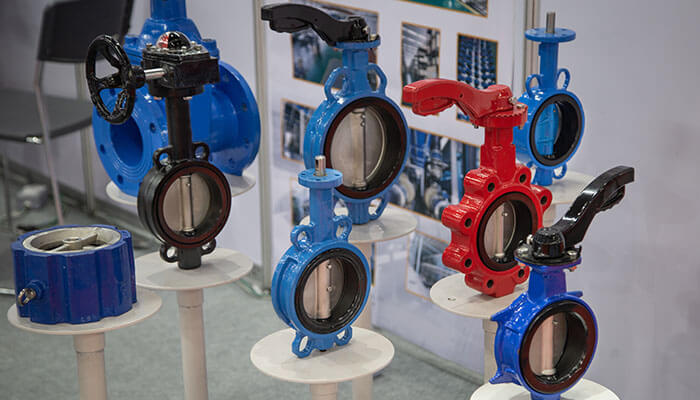In its simplest form, a valve is a device that controls the flow of any substance, including gases, fluidized solids, liquids of any kind, and slurries. This device typically regulates the flow of such substances by opening, closing, or fractionally obstructing various passageways. Military, residential, transportation, commercial, and, of course, industrial applications all make use of this kind of equipment. There are two ways to use these valves: either driven by pressure, as in steam engines for safety reasons, or utilized in a controlled manner, as in camshaft engines, where valves play a significant role in engine cycle control. DomBor butterfly valve manufacturer factory makes industrial butterfly valves that can be customized to your needs using cutting-edge processing equipment.
Many different kinds of valves can be used in a variety of ways. The butterfly valve is a particular kind of valve. This valve, described as a disk rotating on a diametrical axis inside a pipe and is used explicitly in large lines, can also be used as a throttle valve or damper. A type of device that regulates the flow, the butterfly valve is typically used to administer a specific fluid that flows through a particular section of a pipe.
In terms of operation, this valve is comparable to a ball valve. In the middle of the line is the butterfly valve, which has a flat circular plate with a rod through it that connects to a handle on the outside of the valve. Turn the valve handle and the scale either parallel or perpendicular to the flow. The plate in a butterfly valve, unlike a ball valve, is always present in the flow; Consequently, regardless of the valve’s location, the flow always experiences a pressure drop of some kind.
There are three types of butterfly valves. The high-performance butterfly valve, which has a design that is typically double eccentric, can handle pressures up to 725 PSI. The resilient butterfly valve, which has a seat made of pliable rubber, is the second type. This model could handle pressures up to 232 PSI. The last type is the pericentric butterfly valve, which typically has seating made of metal. This valve can control up to 1450 PSI of stress.
Additionally, there are a variety of butterfly valves on the market. Since those who can order wafer-style valves would not even mention the word “wafer,” they would be the most common type of butterfly valve. This plastic butterfly valve comes in two styles: wafer and lug. In contrast, lug-style valves have metal inserts into the valve’s bolt holes. Because they are threaded on both ends, similar to threaded bars, these inserts can be inserted into a particular system with just two bolts and no nuts. This valve, also known as a butterfly damper, uses a disk to control the flow through a specific port.
Latex Gloves in the Medical Field
Medical gloves are frequently used in hospitals and treatment facilities to prevent cross-contamination between patients and caregivers. These disposable gloves are made with various polymers, such as neoprene, nitrile, latex, vinyl, and rubber, among others. These gloves are offered powdered or unpowdered, with corn starch for lubrication, making them easier to use. There are two types of gloves: gloves for surgery and exams. The surgical gloves have better sensitivity and precision because they must meet high standards.
Rubber, vinyl, neoprene, and nitrile are some of the non-latex materials that glove manufacturers now use because it has recently been discovered that people are more likely to be allergic to latex. Even though non-latex materials have begun to be manufactured, latex gloves have yet to be phased out of the market due to the latex glove’s lack of control and sensitivity. As a result, alternative natural materials based on rubber, such as Vytex Rubber Latex, are produced using chemical processes to reduce the number of antigenic proteins in Hevea latex.
High-quality gloves are made from isoprene because they have a chemical structure similar to that of natural rubber latex. However, their prices are higher than those of raw rubber materials. Utilizing non-latex gloves in medical facilities or any clinic has additional advantages. These gloves are frequently worn by healthcare professionals, caregivers, catheter users, lab technicians, dentists, rescue workers, pharmacists, manicurists, and police officers.
Gloves free of powder are always provided in clean medical rooms. The first latex medical glove was produced by Ansell and made available to the public in 1964. It has been discovered that these kinds of gloves are frequently used in criminal activities. However, because the material is so thin, fingerprints can pass through it, creating glove prints. These glove prints helped the police locate the criminals. Kemei, a certified latex surgical gloves manufacturer, protects patients by providing surgical gloves that guarantee their safety throughout the procedure, despite the efforts of medical professionals.
The well-known Watergate burglary serves as an excellent illustration of the aforementioned criminal activity. Using non-latex gloves alerts the surgeon in case of a breach, making it safer. The tensile strength of non-latex surgical gloves is lower than that of surgical gloves; As a result, changing gloves for the surgeon would not be rugged.



